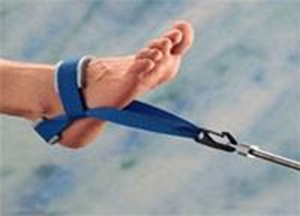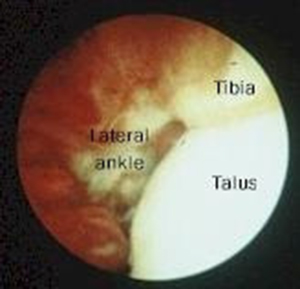- 1300 478 375
Menu
Arthroscopy is an operation on a joint which is done by a “keyhole” technique. An instrument which contains a video camera is inserted into the joint to allow examination of the inside.
By using specially designed probes and instruments, usually most treatments are to the inside of the joint. Arthroscopy of the ankle is usually done after an injury which is failing to settle and where there seems to be damage to the ligaments, lining or surfaces of the ankle. It is also a good way to remove loose fragments from the inside of the ankle.
Sometimes it is done to see how arthritic the joint is, or to treat arthritis by stiffening the joint.


The ankle is first examined carefully with the leg relaxed. A strap is put around your ankle to stretch it so the inside can be seen more easily.
Fluid is injected into the joint. Cuts are then made at the front of the ankle, one at each side. Occasionally another cut is required at the back of the ankle. Each cut is less than 5mm long.
Through these cuts, a camera and instruments are inserted into the ankle. The whole of the inside of the ankle is examined and any necessary treatment carried out.
The ankle is then washed out and the cuts stitched with a single stitch each.
The operation is usually done under general anaesthetic (asleep). Alternatively, an injection in the back or leg can be done to make the foot numb while the patient remains awake. Local anaesthetic injections do not always work and in that case you may have to go to sleep if the operation is to be done. The anaesthetist will advise you about the best choice of anaesthetic for you.
In addition, local anaesthetic may be injected into your leg or foot while you are asleep to reduce the pain after the operation even if you go to sleep for the surgery. You will also be given pain-killing tablets as required.
You don’t need a plaster cast. We want you to start exercising your ankle as soon as possible.
There will be a bulky dressing round your ankle. When you have recovered from your anaesthetic, you can get up, walking freely on your ankle. Dr Sterling will try to discuss the findings of your operation with you before you go home, but if you have not recovered by the time the surgeon leaves the hospital, or if you are ready to go home before the surgeon is free, the ward staff will simply tell you any important message from the surgeon and the findings will be discussed later. If you wish, Dr Sterling will speak to a family member in person or on the phone after the surgery. Please note that if you have had a general anaesthetic, you may not remember what is said to you and so it will all be repeated later.
The bulky dressing can be removed 2 days after the operation. Do not remove the underlying dressings. You should now start exercising your ankle; using both up- and-down and side-to-side movements. The ankle will still be fairly swollen, bruised and stiff at this stage, so you should keep it up when not walking or exercising. If it gets very swollen, you can put some ice on it for 10-15 minutes.
You will be seen again 10-14 days after your operation. Your ankle will be examined. The findings of your arthroscopy will be discussed with you, and any further treatment that is necessary will be arranged. Physiotherapy is often prescribed at this stage. A further check-up will usually be arranged to check your progress.
You can walk on the ankle immediately you have recovered from your anaesthetic. It may be quite sore for a few days and some people need crutches to take some of the weight off their ankle. Almost everyone can walk with their full weight on the ankle within a week.
If you are comfortable and your work is not too demanding, you could go back to work within a week. However, if you have a heavy manual job, or have had extensive surgery within the ankle, you may not be able to go back for a month or more.
Please note, if you have had an arthroscopy of your knee before, that the recovery from an ankle arthroscopy takes about half as long again as a knee procedure.
If you have an automatic car and have an operation on your left ankle, you could drive within a couple of days of the operation. Otherwise you can drive about 1-2 weeks after surgery, depending mainly on your comfort.
As you recover from your operation, you can gradually increase your activity, determined by comfort and the amount of swelling and flexibility in the ankle. Start with walking and cycling, then light running. Make sure your foot and ankle are fairly flexible before moving to twisting or impact activities, and make sure you can turn and jump comfortably before returning to contact sports.
Your return to sport will also depend on the damage to your ankle which caused you to have surgery in the first place, and on any other necessary treatment. As this operation tends to be done for problems following an injury, this is an important factor in recovery for many people. All other things being equal, most people will get back to their previous level of activity in 2-3 months.




Take the first step towards your treatment and book your initial appointment with our orthopaedic surgery team.
Prefer the phone? 1300 478 375


